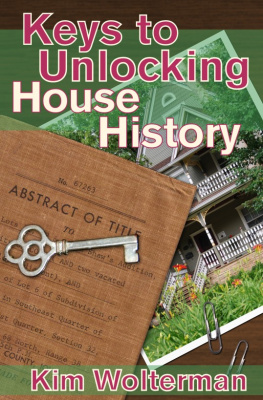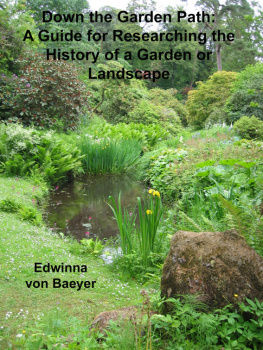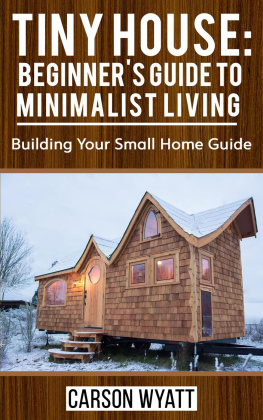Keys to Unlocking HouseHistory
by
Kim Wolterman
Copyright 2011 Kim Wolterman
Smashwords Edition
Smashwords Edition, License Notes
This ebook is licensed for your personalenjoyment only. This ebook may not be re-sold or given away toother people. If you would like to share this book with anotherperson, please purchase an additional copy for each recipient. Ifyoure reading this book and did not purchase it, or it was notpurchased for your use only, then please return to Smashwords.comand purchase your own copy. Thank you for respecting the hard workof this author.
Cover images courtesy of Kim Wolterman &Robert Harris
Cover by Joleene Naylor
Table of Contents
Preface
Obtaining a century home plaque for my house.It seemed a simple enough goal. All I needed were two pieces ofdocumentation to prove the house was built in 1902. Surely a quicktrip to my local historical society office would provide thenecessary information. Right? Not exactly. It took three years andcountless trips to multiple libraries, historical societies, thecounty government center and, ultimately, a trip to Chicago, beforeI was finally able to make application for my plaque.
Keys to Unlocking House History isdesigned to give the reader what I didnt have a systematic planto follow in researching a property. The intent is to remove thefrustration and put the fun into the endeavor. When the reader runsinto brick walls (sometimes, literally!), the book will provideother avenues to explore.
There is a huge interest in the documentationand preservation of historic structures in the United States. Someof this interest comes from owners who are applying for historicalbuilding status. Others are seeking to understand the previousowners and why certain modifications were made to their homes.Additionally, there is a growing desire on the part of manygenealogists to find out where their ancestors lived and what theirneighborhoods were like at the time they lived there.
There are a number of books available onresearching house history. While some of the research areas coveredin this book are the same as in existing books, Keys toUnlocking House History provides researchers with astep-by-step guide on where to find local resources to assist inthe search.
Introduction
If you are reading this book, you probablyown an historic home. But someone owned it before you. You may beinterested in researching the history of your house for manyreasons. It may be that you are restoring or rehabilitating an oldhouse. Maybe you are seeking historic designation for the property.Perhaps you want to obtain a century home plaque from your localhistorical society. Or maybe you are among the growing number ofgenealogists who want to find out about an ancestors home.
Whatever your motivation, learning about anold house and its history can be interesting and rewarding. It canalso be frustrating. Often people do not know where to go to obtaininformation helpful to their research. Typically there is no onelocation that contains all the records necessary to complete yoursearch. This book will provide you with a systematic approach toyour research, offering information and tools that you can use tolearn more about the house you are investigating. Its purpose is toguide you through the sometimes baffling maze of county, municipaland other records to those that are the most likely to containpertinent information for compiling a house history.
You may exhaust all the possible avenues andstill not find answers to your questions. But no matter what theend result, you will still uncover some interesting informationabout your house and the community it was built in.
Documenting house history is more than justwriting down names and dates. Your completed research will paint apicture of life in the past in your home and neighborhood. Not onlywill this be of interest to you, but future homeowners andgenealogists will treasure your findings and be able to add to themas well.
So, have fun and good luck!
Section One: OrganizingYour Research
The first step is to decide how you willorganize the information you obtain. There is nothing morefrustrating than trying to find an old scrap piece of paper thatyou know you took notes on unless it is going over ground youhave already covered because you cant remember which sources youhave looked at in the past. Because most people will do theresearch over a period of months, or even years, it is impossibleto remember what has been done without an organized file.
Filing Your Information
During my research, I found it most helpfulto utilize a three ring binder with dividers separating the varioussources of research i.e., directories, title searches,correspondence, etc. If all notes are made on 8 " x 11" sheets ofpaper they can then be easily inserted into the proper section ofthe binder. Writings on small scraps of paper tend to get lost. Ifyou do make a note on a smaller piece of paper, copy it onto an 8" x 11" sheet of paper later. Most other photocopies made duringthe search process will also be this size, making everythingconsistent and easy to file.
Recording Information
Record information as soon as you find it andwrite down, in detail, where and when a search was made. Keep trackof everything you look at, even those items that contain no usefulinformation. Write down the source by author and title, or the filenumber if that is how the institution listed it. Also note anycontacts you make, whether by letter, phone, email or in person.You will be able to see at a glance which resources you havealready reviewed. A research log can also help you plan futuretrips as well. You can list the sources you wish to review when yougo to the library, courthouse, etc. and note the call or microfilmnumbers so you save time once you are at the repository.
Keep a research log for all of your internetresearch as well. Again, you dont want to keep revisiting websites you have already checked in the past.
Start a Research To Do List
Organize your research tasks in an efficientand logical fashion. Decide what you need to know and where you canfind it. Make a list of specific tasks, noting where you need togo, to whom you need to speak, what you expect to find, and theorder in which you intend to proceed. You can modify this list asyou proceed with your research.
Use Archival Safe Materials
As you begin to accumulate photos, documentsand newspaper clippings, make certain that all of your copies aremade on archival-quality paper. All storage boxes and bindersleeves should be archival safe as well. Before storing photos,label each one with a photo-safe marking pencil, noting the date,location and any subjects in the photo.
Key: A quick internetsearch for archival safe materials will yield dozens of sources forpaper, pens, boxes, etc.
How OldIsThisOld House?
If you are the owner of the house, you mayhave received an informational sheet from the realtor when youfirst looked at your house. Almost always these sheets contain adate indicating when the house was built. While it is definitelyuseful in narrowing down a construction date, dont assume thelisted date is accurate. The same is true with the date that yourlocal county has on record as being the year the house was built.Use this date as a starting point, but search for data to prove itslegitimacy.
Walk the Property
Before heading off to look through records,start with what is right in front of you. The property itself is aprimary source of information. With a notebook and pen in hand,walk the entire property. Take a close look at all buildings andstructures, inside as well as out, noting distinctive features andobvious alterations and changes. Look for evidence of previousbuildings, roadways, paths, fences, and other features. The styleof a building is a clue to its age, as are the materials used inconstruction. The foundation material and types of nails used canhelp to establish a construction date. During remodeling, somehomeowners have found old newspapers which were used as insulation,helping to date the structure. Several good books on architecturalclues and styles are listed in the bibliography.
Next page












